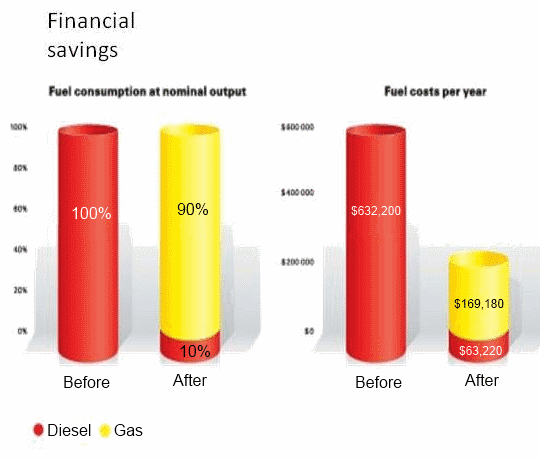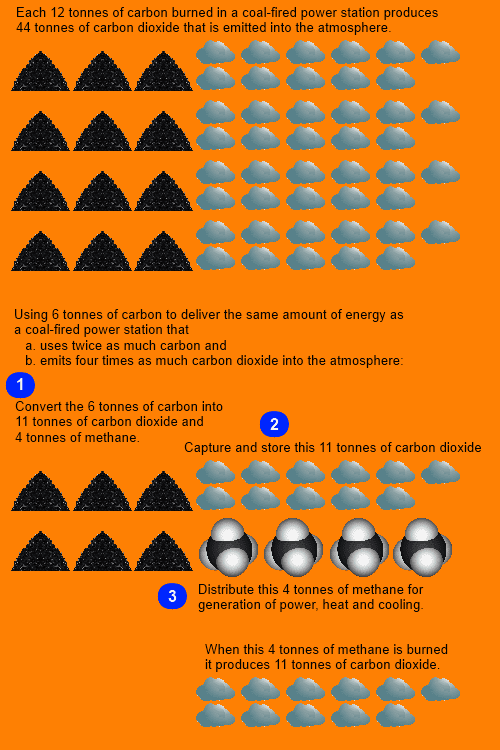Miranda Devine's article "
Has science become an alternative religion?" copied below equates environmentalism with science. These are not the same thing.
Science and technology show that we can halve the amount of coal needed to generate the energy we now use, cut CO2 emissions by 75 percent, and do this while delivering energy at a reduced cost:
Dakota Gas owns the Great Plains Synfuels Plant in Beulah, North Dakota that has operated since 1984.
It produces synthetic natural gas from brown coal.
Dakota Gas captures and sells CO2 produced at the plant.
CO2 from other power plants is very wet and diluted with nitrogen and oxygen and requires further processing, but Dakota Gas' process results in a CO2 stream that is very dry and 96 percent pure, so no additional processing is needed.
How to Halve Coal Demand and Cut Emissions by 75 per cent
while Saving Money
|
Environmentalists oppose this technology. This group believes reliance on non-renewable energy resources must be ceased without delay. Note that this rejection of fossil fuels is quite separate from any risk of climate change that may or may not be caused by burning fossil fuels.
The fossil-fuel industry has an obvious lack of enthusiasm for this technology that gives us such a dramatic increase in energy efficiency. It results in demand for coal dropping by 50 per cent.
China on the other hand wishes to reduce its reliance on energy imports and to lower the cost of energy. It is increasingly building synthetic natural gas plants. Some examples (These links open web pages in new tabs):
- Synthetic gas from coal: Siemens to supply eight 500 MW coal gasifiers to China
- India's coal-to-gas dream takes baby steps (Note: "In comparison, China has some 50 coal gasification plants running and it is ploughing ahead with another 40.")
- China Power Investment Corporation has awarded Haldor Topsøe the contract for a 2 billion Nm3 per year Coal to SNG plant in Xinjiang, China
- GE Demonstrates Scale and Fuel Flexibility of Its Gasification Technology at Two Major Projects in China
- Topsoe awarded the third coke oven gas to SNG plant in China
For examples of savings in energy costs that result from using the technology described above, read more at
A Tale of Two Shopping Centres.
Environmentalism has only a vague acquaintance with logic. This distinguishes it from science. For instance, it
believes renewable energy technology is "necessary" even though it is clearly incapable of slowing growth in global demand for coal. Faced with this chronic failure, environmentalism still rejects out-of-hand available technology that halves the demand for coal. Logical thinking is not in evidence here. Environmentalism would prefer making no progress at all than get halfway to the "necessary" goal if this involves any use of despised fossil fuels.
Enter the climate change sceptics
Just as the environmentalists do not rely on climate science to justify their dislike of fossil fuels, the marketers of fossil fuels do not need climate science scepticism to justify their dislike of energy-efficiency technology that reduces the demand for fossil fuels.
However, it is logical to change a debate to a subject that cannot be quickly answered.
A debate in which the coal industry argues we should reject the available technology to reduce the cost of energy would be over very quickly.
The climate sceptics view of the world contains clear indications that it is an illogical invention of the fossil fuel industry. The clearly false assertions below serve only one purpose: To avoid engaging in the argument that we can create energy more cheaply with less fuel:
"The Kyoto Protocol, if implemented, reduces emissions by a mere five percent among industrialized nations only. But this would have a devastating effect on the economy of our nation."
"It is not possible to reduce carbon dioxide emissions, much less to stabilize or reduce atmospheric carbon dioxide concentrations, without severe restrictions on the use of coal, oil, and natural gas. This means a global regime of severe energy rationing, because it is not possible to replace these essential fuel sources with technology that is currently available and affordable."
"The use of coal and hydrocarbon fuel has another, more obvious effect: fueling the agriculture and industry that lifts billions of people from poverty and misery. Without abundant, economical sources of energy, millions of people would die and millions more would be reduced to dire poverty."
Miranda Devine | From:
Sunday Herald Sun | March 18, 2012
12:00AM
THE three wise monkeys of Australian climate science, professors Will Steffen, Matthew England and David
Karoly, posted a self-justifying report on the Climate Commission website last week linking recent floods, heavy rain and low temperatures to global warming.

|
Historian Geoffrey Blainey, suggests science has become an "alternative religion".
AFP
|
"The science behind southeast Australia's wet, cool summer" is
their explanation for why the much-ridiculed predictions of endless
drought by fellow climate activists, such as Climate Commissioner Tim
Flannery, failed to materialise.
"The wetter conditions
experienced in southeastern Australia in the last two years are
consistent with scientists' knowledge and understanding of how the
climate is changing in the long term," they write.
It's just the media that got it wrong.
"Most
parts of Australia have experienced exceptionally heavy rains over the
past two years, filling many dams around the country ... There has been
much confusion in the media about what this means for climate change."
It's a pity these scientists weren't so proactive when the media was lapping up Flannery's Armageddon forecasts.
And no, contrary to Malcolm Turnbull's claims last week, Flannery wasn't "verballed".
It's a matter of public record that Flannery has warned of endless drought for years.
In
2007 he predicted, "rainfall across eastern Australia will reduce until
a semi-permanent El Nino-like (drought) state is induced".
"Blind faith in alarmist predictions has serious consequences"
He urged desalination plants be built within 18 months.
He claimed, "even the rain that falls isn't actually going to fill our dams and our river systems".
He was wrong.
But through his best-selling book The Weather Makers, the Climate Commissioner influenced a lot of Australians.
Blind faith in alarmist predictions has serious consequences.
In
last year's floods in Brisbane, for instance, we now know that
engineers at the Wivenhoe dam chose to believe the doomsayers rather
than the evidence of their own eyes and the actual weather forecast that
told them the drought had broken and Dorothea Mackellar's "flooding
rains" were back.
Conditioned to believe permanent drought was the new reality, the engineers hoarded water.
Instead
of releasing it slowly and early, they waited until it was too late,
and huge volumes of water escaping from the dam flooded Brisbane,
engulfed 15,000 homes and businesses.
The hapless engineers, now facing criminal charges, are the scapegoats.
But
the real culprits are opportunistic politicians and mad greenies, whose
apocalyptic warnings supersede prudence and common sense.
With just four months left until the advent of the carbon tax, the alarmists have regrouped.
Without
admitting any errors of the past, they blithely explain away the
inconvenient truth of all that rain and ramp up Armageddon scenarios
that justify the tax.
With the IPCC's Fifth Assessment Report due next year, the hyperbole meter is set to screech.
Historian Geoffrey Blainey, speaking last week, suggests science has become an "alternative religion".
Research
into his new book, A Short History of Christianity, leads him to think
our attitude towards science in an era of technological advances is akin
to religious faith, with gods to worship, a vehemence of belief, good
and evil, heretics and saints.
He says alternative religions have taken the place of Christianity, including communism, and nature worship.
The third alternative religion is "science, its cousin technology and its god, reason".
"Science has become incredibly powerful and influential, which is understandable.
So
much of our increased standard of living in the last 150 years has come
from science and technology and understandably science is worshipped by
a large number of people."
MIT atmospheric physicist Professor Richard Lindzen also views climate alarmism as "quasi-religious".
Climate alarmists want science to act as the servant of politicians pushing for carbon control.
That is not the role of science.
















